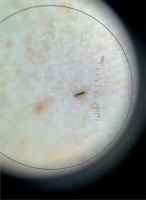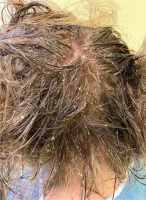Pediculosis capitis is a prevalent condition affecting people worldwide, caused by infestation with Pediculus humanus var. capitis. It primarily affects children aged 3 to 12 years old [1]. While most patients experience scalp pruritus, the infestation’s course can range from asymptomatic to aggravated by complications such as impetiginisation, plica polonica (Polish plait), and contact dermatitis triggered by louse saliva, itching, and scratching [2–4].
Mismanagement of lice infestations and poor hygiene can lead to plica polonica, characterized by thick, matted, and tangled hair masses teeming with lice and nits [2]. Although exceedingly rare nowadays, some cases may necessitate hair cutting, a measure that can significantly stigmatize patients.
A recent case involved a 10-year-old girl admitted to the dermatological department with pediculosis capitis and erythematous papules on her upper trunk, along with erosions on the rest of her body. Her symptoms began 2 weeks earlier, initially treated at home with a tincture containing Delphinium consolida. However, after 7 days, she developed skin lesions on her face and upper trunk. Pediculosis capitis was transmitted by contact with infested children at school, which is the most common mode of transmission.
Upon examination, the scalp exhibited erythematous-exfoliative lesions and erythematous-exudative lesions with erosions and crusts. Disseminated papules and erosions were also found on her trunk and extremities. Dermatoscopic examination revealed lice on the skin and allowed to exclude scabies infestation (Figure 1). Her hair was matted, covered with exudates, and infested with numerous nymphs and some adult lice, forming a plica polonica resembling a “bird’s nest” (Figure 2). Due to the hair’s tangled state, it was necessary to cut the matted strands. Considering the skin condition and infestation severity, treatment comprised dimethicone (80 mg daily), corticosteroids (initially dexamethasone 8 mg intramuscularly, tapered to 4 mg), antihistamines (hydroxyzine 10 mg twice daily), and topical corticosteroids (momecutan lotion daily).
The persistence of lice infestation, development of plica polonica, and subsequent hair cutting significantly impacted her mental well-being, necessitating psychological counselling. Following treatment, her clinical condition improved, leading to hospital discharge.
Pediculosis capitis poses not only physical complications but also psychological ones. School absenteeism, social withdrawal, peer criticism, and, rarely, hair cutting as a last resort treatment contribute to anxiety and other psychological issues.
Given the high prevalence of pediculosis, numerous over-the-counter treatments are available. However, patients should seek medical attention for severe cases or complications. One such complication is contact dermatitis, resulting from extensive pediculosis and presenting as erythematous, exfoliating, and exudative lesions throughout the body [4, 5], similar to the described patient’s condition. Successful management includes pediculosis treatment and inflammation suppression with systemic corticosteroids, as evidenced in our case [3].
Head lice infestation may lead to a rare complication known as plica polonica, characterized by irregularly intertwined hair. Historically associated with Polish society in the 16th century, it could also result from prolonged neglect of long hair during psychiatric illness, excessive combing, chemical exposure from shampoos, or chronic diseases [6–8]. Hair entangled with dirt, exudates, and keratin forms matted masses resembling bird nests, observed in our patient. Early-stage treatment involves manually separating hair strands, whereas in advanced stages, cutting or shaving becomes necessary [8].
This case underscores the potential severe consequences, both physical and psychological, of pediculosis. Timely treatment upon diagnosis is paramount in preventing such complications.










